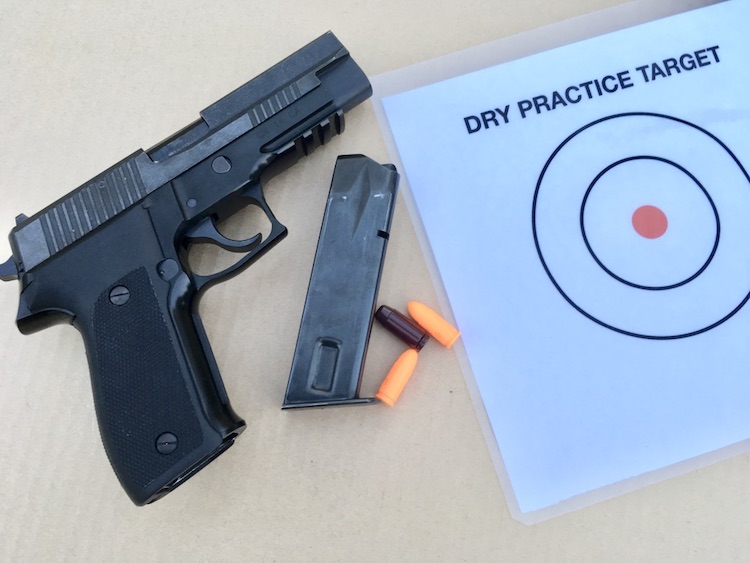
Trigger control - or perhaps the lack of it - is one the main contributing factors to shooters missing their mark and, as with everything in life, the only way to get better is to practice.
The good news is that you don’t need to go to the range and blow through a hundred buck’s worth of ammo to improve your trigger control: you can practice at home with a “dry” (empty) firearm.
Most modern centre-fire firearms can be dry fired without a dummy cartridge or snap-cap, but it does pay to check with the manufacturer first. If in doubt, dummies for almost every calibre can be had for cheap at almost every gun store.
Note: Due to the position of the firing mechanism on rim-fire guns, dry firing without a dummy cartridge could chip the chamber or cause the firing pin to snap. So dummies are a must for any rim-fire firearm.
Before you get your firearm out of the safe, you need to create an appropriate space to practice. As long as you’re being safe, there’s nothing wrong with practicing your trigger control in your living room. But make sure that you aren’t going to scare your neighbours (or any other passers by) - you don’t want your practice session interrupted by a visit from the cops!
If you do use a regular household room, be aware that ejected dummy cartridges can often disappear under couches and down air vents.
Next, you need to pick the safest available direction and put up a target. This gives you something to align your sights on. I prefer to use a target marked especially for practice - it helps my brain to differentiate from live fire training and focus on the task at hand. The target doesn’t have to be far away; just the other side of a room will work fine. If you have a ballistic backstop then it’s a good idea to use it.
Then you must remove all live ammunition from area. Double check to make sure that any cartridges you have available are dummies, and lock live ammo away.
If you’re using a pistol, this is also a good training opportunity to practice your draw, so strap on your belt and holster.
Now you’re ready to get your firearm out of the safe - and as you do so, make sure to PROVE it safe.
Just because you’re practicing with dummy ammo does not mean that you can be slack with your safety: whenever you handle firearms, always follow the safety rules: 1 - Keep firearms pointed in the safest available direction; 2 - Treat all firearms as loaded; 3 - Keep trigger and trigger guard clear until you are pointing at a legitimate target and ready to fire; 4 - Be sure of your target and its surroundings.
At this stage, I recommend announcing that you are beginning dry practice. This is for your benefit as much as it is anyone else who may be present, as it helps to get your mindset on track for non-live fire practice.
Present the firearm in your normal body position, align your sights on the target and ,when you have obtained a good sight picture, try ten controlled trigger presses. It isn’t a race. It’s about being controlled.
Watch how the firearm moves when you press the trigger. In the case of practicing with a handgun, if the muzzle moves towards your dominant side (to the right if you're right-handed), then you probably have too much of your finger curled around the tigger. If the pistol moves away from your dominant side, then you probably don't have enough of your finger on the trigger. Most people find the right place is somewhere between the finger tip and the first knuckle crease.
Using a camera to video yourself as you practice can help you see how the firearm moves. Focus on eliminating all movement except your trigger finger moving rearward.
Once you’ve got the hang of this, you can up the challenge by balancing something, like a quarter or other small coin, on top of the firearm, then practice pressing the trigger without disturbing the coin.
You can start by laying the coin flat on the top of the slide or receiver. It may sound easy, but it’s harder than it looks.
Once you have mastered consistently pressing the trigger without moving the coin, you can relocate it to somewhere more challenging, such as on top of the front sight post. Some trigger control gurus even practice with the coin balancing on it’s edge!
Whilst the techniques above work well for rifles and handguns, they have limited benefit for shotguns. This is largely because shotguns are typically used for shooting at moving targets. In this case, you can practice shotgun trigger control by swinging the gun through an arc and pressing the trigger as you swing. This requires much more space, particularly in terms of safe direction - you must make sure that the muzzle direction is safe for the entire swing. The idea here is to practice until you can consistently press the trigger without allowing the gun to diviate from its arc.
Spending as little as fifteen minutes a week practicing these techniques will greatly improve your trigger control and give you much better chances of hitting your target.
If you want refresher on the basics, check out our series on Firearms Fundamentals starting with Part 1: Safety.